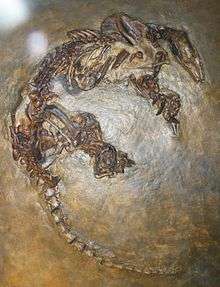Pholidotamorpha
Pholidotamorpha is a clade of mammals that includes the clades Palaeanodonta and Pholidota (the pangolins). In the past both orders were formerly classified with various other orders of ant-eating mammals, most notably Xenarthra, which includes the true anteaters, sloths, and the armadillos which pangolins superficially resemble. Newer genetic evidence, however, indicates their closest living relatives are the Carnivora with which they form the clade Ferae.[2][3] Some palaeontologists, placing Ernanodonta in a separate suborder of Cimolesta near Pholidota,[4] have classified the pangolins in the order Cimolesta, together with several extinct groups indicated (†) below, though this idea has fallen out of favor since it was determined that cimolestids were not placental mammals.[5] A 2015 study has supported close affinities between pangolins and the extinct group Creodonta, as well as many former cimolestans (Cimolestes itself was recovered as a far more basal mammal).[6]
- Pholidotamorpha Gaudin et al. 2009
- Palaeanodonta Matthew, 1918
- Genus †Arcticanodon Rose, Eberle & McKenna, 2004
- Species †Arcticanodon dawsonae Rose, Eberle & McKenna, 2004
- Genus †Melaniella Fox, 1984
- Species †Melaniella timosa Fox, 1984
- Genus †Molaetherium Heissig, 1982
- Genus †Amelotabes Rose, 1978
- Species †Amelotabes simpsoni Rose, 1978
- Family †Escavadodontidae Rose & Lucas, 2000
- Family †Epoicotheriidae Simpson, 1927
- Family †Metacheiromyidae Wortman, 1903
- Family †Ernanodontidae Ding 1979
- Genus †Arcticanodon Rose, Eberle & McKenna, 2004
- Pholidota Weber, 1904
- Genus †Argyromanis Ameghino, 1904
- Species †Argyromanis patagonica
- Genus †Orthoarthrus Ameghino, 1904
- Species †Orthoarthrus mixtus
- Genus †Euromanis (Storch & Martin, 1994) Gaudin, Emry & Wible, 2009 [Eomanis krebsi Storch & Martin, 1994]
- Species †Euromanis krebsi
- Genus †Eurotamandua Storch, 1981
- Species †Eurotamandua joresi
- Eupholidota Gaudin, Emry & Wible, 2009
- Family †Eomanidae Storch, 2003
- Superfamily Manoidea
- Family †Patriomanidae Szalay & Schrenk 1998 sensu Gaudin, Emry & Pogue, 2006
- Family Manidae Gray, 1821
- Genus †Argyromanis Ameghino, 1904
- Palaeanodonta Matthew, 1918
| Pholidotamorphs | |
|---|---|
 | |
| Fossil of Eurotamandua joresi | |
| Scientific classification | |
| Kingdom: | Animalia |
| Phylum: | Chordata |
| Class: | Mammalia |
| Clade: | Ferae |
| Clade: | Pholidotamorpha Gaudin et al., 2009 |
| Clades | |
References
- Mark S Springer, Christopher A Emerling, John Gatesy, Jason Randall, Matthew A. Collin, Nikolai Hecker, Michael Hiller, Frédéric Delsuc (2019) Odontogenic ameloblast-associated (ODAM) is inactivated in toothless/enamelless placental mammals and toothed whales
- Murphy, Willian J., et al. (2001-12-14). "Resolution of the Early Placental Mammal Radiation Using Bayesian Phylogenetics". Science. 294 (5550): 2348–2351. Bibcode:2001Sci...294.2348M. doi:10.1126/science.1067179. PMID 11743200.
- Beck, Robin MD; Bininda-Emonds, Olaf RP; Cardillo, Marcel; Liu, Fu-Guo; Purvis, Andy (2006). "A higher-level MRP supertree of placental mammals". BMC Evolutionary Biology. 6 (1): 93. doi:10.1186/1471-2148-6-93. PMC 1654192. PMID 17101039.
- For example, McKenna & Bell 1997, p. 222 in which they included palaeanodonts. (Rose 2006, p. 210)
- Rook, D.L.; Hunter, J.P. (2013). "Rooting Around the Eutherian Family Tree: the Origin and Relations of the Taeniodonta". Journal of Mammalian Evolution. 21: 1–17. doi:10.1007/s10914-013-9230-9.
- Halliday, Thomas J. D.; Upchurch, Paul; Goswami, Anjali (2015). "Resolving the relationships of Paleocene placental mammals". Biological Reviews: n/a–n/a. doi:10.1111/brv.12242. ISSN 1464-7931.